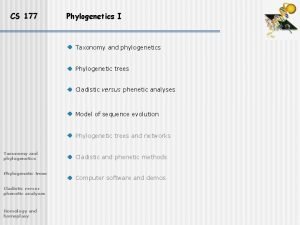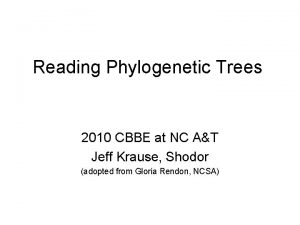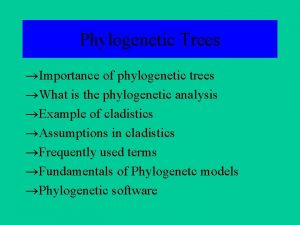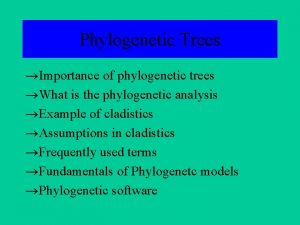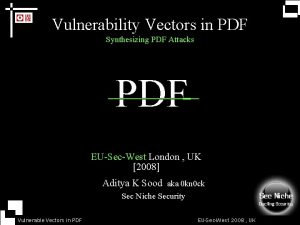Phylogenetic Trees Lecture 13 NOTE THE PDF FORMAT











- Slides: 11

Phylogenetic Trees Lecture 13 NOTE: THE PDF FORMAT INCLUDES MORE SLIDES Background reading: Durbin et al Chapter 8. . This class consists of parts of Prof Joe Felsenstein’s lectures 4 and 5 taken from: http: //evolution. genetics. washington. edu/genet 541/2002/lecture 5. pdf and on Chapter 8. 2 of Durbin et al. Edited by Dan Geiger.

Three Methods of Tree Construction Distance- A tree that recursively combines two nodes of the smallest distance. u Parsimony – A tree with a total minimum number of character changes between nodes. u Maximum likelihood - Finding the best Bayesian network of a tree shape. The method of choice nowadays. Most known and useful software called phylip uses this method. http: //evolution. genetics. washington. edu/phylip. html u 2

Maximum Likelihood Approach Consider the phylogenetic tree to be a stochastic process. AAA AAG AAA AGA GGA AGA Unobserved Observed The probability of transition from character a to character b is given by parameters b|a. The probability of letter a in the root is qa (written a in Felsenstein’s slides). These parameters are defined via rates of change per time unit times the time unit. Given the complete tree, the probability of data is defined by the values of the b|a ‘s and the qa’s. 3

Maximum Likelihood Approach Assume each site evolves independently of the others. A A G A A A G G G A A A Pr(D|Tree, )= i Pr(D(i)|Tree, ) Write down the likelihood of the data (leaves sequences) given each tree. Use EM to estimate the b|a parameters. When the tree is not given: Search for the tree that maximizes Pr(D|Tree, EM)= i Pr(D(i)|Tree, EM) 4

The Jukes-Cantor model (1969) We need to develop a formula for DNA evolution via Pr(y|x, t) where x and y are taken from {A, C, G, T} and t is the time length. Jukes-Cantor assume equal rate of change: A C -3 G T 5

The Jukes-Cantor model (Cont) We denote by S(t) the transition probabilities: We assume the matrix is multiplicative in the sense that: S(t+s) = S(t) S(s) for any time lengths s or t. 6

The Jukes-Cantor model (Cont) For a short time period , we write: By multiplicatively: S(t+ ) = S(t) S( ) S(t)(I+R ) Hence: [S(t+ ) - S(t)] / S(t)R Leading to the linear differential equation: S`(t) S(t)R With the additional condition that in the limit as t goes to infinity: 7

The Jukes-Cantor model (Cont) Substituting S(t) into the differential equation yields: Yielding the unique solution which is known as the Jukes-Cantor model: 8

Kimura’s K 2 P model (1980) Jukes-Cantor model does not take into account that transitions rates (between purines) A G and (between pyrmidine) C T are different from transversions rates of A C, A T, C G, G T. Kimura used a different rate matrix: 9

Kimura’s K 2 P model (Cont) Leading using similar methods to: Where: 10

Hasegawa, Kishino & Yano model (1985) Still the equilibrium probabilities are all ¼ in Kimura’s model, despite the facts that in many organisms show strong bias in their AT to CG ratio. HKY’s model takes care of this. Also Felsenstein’s model F 84 takes care of this problem. There are other models as well, the most general of which is a matrix where all rates of change are distinct (12 parameters). The following chart shows relationships among most used models. 11
 Dichotomous key pogil
Dichotomous key pogil Scaled vs unscaled phylogenetic tree
Scaled vs unscaled phylogenetic tree Phylogram vs cladogram
Phylogram vs cladogram 01:640:244 lecture notes - lecture 15: plat, idah, farad
01:640:244 lecture notes - lecture 15: plat, idah, farad Lecture note tiu
Lecture note tiu Difference between note making and note taking
Difference between note making and note taking Signal wods
Signal wods Difference between note making and note taking
Difference between note making and note taking Goods received note vs delivery note
Goods received note vs delivery note Debit note meaning
Debit note meaning Debit memo
Debit memo Note taking and note making
Note taking and note making

